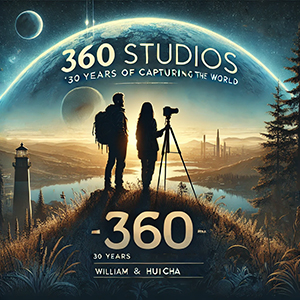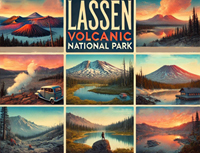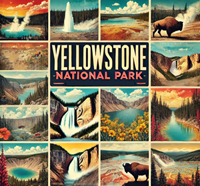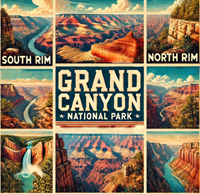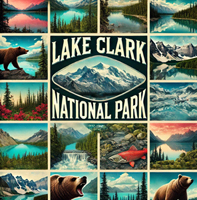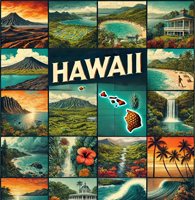
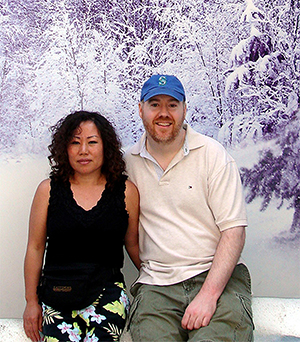
Embark on a journey curated by seasoned explorers William and Hui Cha Stanek, who have spent decades immersing themselves in the diverse landscapes of North America. These itineraries are more than just travel plans - they are thoughtfully crafted adventures designed to help you connect with the natural world, discover hidden gems, and create lasting memories.
National Parks Index | US Itineraries Index | American Roadtrips Index

Bring home a Bugville Critters book and watch as your child's love for reading and learning grows with every page. Hand-painted illustrations bring the heartwarming stories to life. Ask your librarian to add Bugville Critters to the library's digital collection today!
Discover William Stanek's Exclusive Art Collection
Explore and purchase the stunning art featured on this site. Own a piece of William Stanek's unique and captivating artwork today!
(May 9, 2025) Finding Solace in the Desert: 3-Days Exploring Joshua Tree and Anza-Borrego
It was late October when Hui Cha and I ventured into the arid landscapes of Southern California, seeking a place where the world slowed down, where we could disconnect from the relentless pace of life and reconnect with nature and each other. Joshua Tree National Park and Anza-Borrego Desert State Park seemed like the perfect destinations – two iconic desert parks that promised solitude, surreal landscapes, and the kind of peace that only the desert can offer.
For Hui Cha, this trip was a chance to revisit memories of her childhood, growing up in the busy streets of Seoul, where the only "desert" she knew was the small, sandy playgrounds of her youth. The vastness of the American desert was something completely foreign and yet deeply intriguing to her. For me, William, it was a return to the roots of my photography – capturing the stark beauty of places where life seems both fragile and resilient, where the light and shadows play in ways that transform the ordinary into something extraordinary.
As we drove into Joshua Tree just before dawn, the silhouettes of the park's namesake trees began to appear against the dim sky, their twisted forms creating a strange and beautiful landscape. There was something almost otherworldly about this place, as if we had stepped onto another planet, one where time moved differently and the vast expanse of the desert stretched out endlessly before us.
This trip wasn't just about photography; it was about finding a space to breathe, to reflect, and to appreciate the simple, raw beauty of the desert. As we moved from the rugged terrain of Joshua Tree to the wide-open spaces of Anza-Borrego, we found ourselves not just capturing images, but capturing moments – moments of stillness, of awe, and of connection.
In this guide, we'll take you through our detailed itineraries, share our best tips for capturing the unique beauty of these parks, and offer alternative activities for those seeking a less strenuous adventure. Whether you have just one day or a full three days to explore, this guide will help you make the most of your journey through these stunning desert landscapes.
Day 1: Discovering the Wonders of Joshua Tree National Park
Morning: Sunrise at Cholla Cactus Garden
6:00 AM - Sunrise at Cholla Cactus Garden
Overview: Start your day in Joshua Tree with a sunrise at the Cholla Cactus Garden, one of the most unique and photogenic spots in the park. As the first light of day illuminates the cacti, their spines catch the sun's rays, creating a glowing, almost surreal landscape that feels like something out of a dream.
Tips from William: "Arrive at least 30 minutes before sunrise to set up your gear. A wide-angle lens is essential here to capture the vastness of the garden and the soft, golden light that makes the cacti glow. Use a tripod to ensure sharpness, and consider using a shallow depth of field (f/2.8 or f/4) to isolate individual cacti and create a sense of depth in your images."
Insights from Hui Cha: "The early morning air can be quite chilly, even in the desert, so dress warmly and bring a thermos of hot tea or coffee. The cacti are beautiful but also very prickly, so be mindful of where you step and always watch your hands when setting up your tripod."
How to Access Cholla Cactus Garden:
- Location: Cholla Cactus Garden is located in the southern part of Joshua Tree National Park.
- Travel Directions: From the Joshua Tree Visitor Center, take Park Boulevard for about 12 miles, then turn right onto Pinto Basin Road. Continue for about 20 miles until you reach the Cholla Cactus Garden parking area.
- Trail Details: The garden features a short, easy 0.25-mile loop trail that winds through the dense concentration of cholla cacti. The trail is flat and well-maintained, making it accessible to all visitors.
Alternative Activity: Barker Dam
- If you prefer a less prickly experience, consider starting your morning at Barker Dam. This easy 1.3-mile loop offers beautiful reflections in the early morning light, with the surrounding rock formations and Joshua trees creating stunning compositions.
Photographic Techniques:
- Golden Hour Lighting: The soft, golden light of sunrise will enhance the colors and textures of the cacti. Position yourself so that the light is coming from the side or behind the cacti to create a glowing effect.
- Close-Up Shots: Use a macro lens or zoom in to capture the intricate details of the cactus spines. These close-ups can create abstract, almost otherworldly images.
- Backlighting: Experiment with backlighting the cacti by positioning the sun behind them. This will make the spines glow and create dramatic silhouettes against the rising sun.
Exploring the Area:
- After photographing the Cholla Cactus Garden, take a leisurely drive along Pinto Basin Road, which offers additional opportunities for desert photography. Keep an eye out for wildlife, such as jackrabbits and roadrunners, which are more active in the early morning hours.
Midday: Hiking Hidden Valley
10:00 AM - Hidden Valley Trail
Overview: Hidden Valley is one of Joshua Tree's most popular hiking spots, known for its unique rock formations and the secluded nature of the valley itself. This area is perfect for a mid-morning hike, offering both scenic views and fascinating geological features.
Tips from William: "The light can be harsh by mid-morning, so focus on the textures and shapes of the rocks. Use a mid-range zoom lens (24-70mm) to play with different compositions, and consider shooting in black-and-white to emphasize the contrast between light and shadow."
Insights from Hui Cha: "This is a relatively easy hike, but the terrain can be uneven, so wear sturdy shoes. Bring plenty of water and a snack, as the desert heat can sneak up on you even in the cooler months. Take your time exploring the nooks and crannies of the rock formations – you never know what interesting details you might find."
How to Access Hidden Valley Trail:
- Location: Hidden Valley is located in the northwestern part of Joshua Tree National Park.
- Travel Directions: From Cholla Cactus Garden, head back north on Pinto Basin Road, then turn left onto Park Boulevard. Continue for about 15 miles until you reach the Hidden Valley parking area.
- Trail Details: The Hidden Valley Trail is a 1-mile loop that takes you through a rock-enclosed valley. The trail is well-marked and offers plenty of opportunities to explore side paths and climb on the rocks.
Alternative Activity: Skull Rock
- For those looking for a shorter, less strenuous option, Skull Rock is an excellent alternative. Located just off Park Boulevard, this iconic rock formation resembles a giant skull and is easily accessible from the road.
Photographic Techniques:
- Rock Formations: Focus on the unique shapes and patterns in the rocks. Look for natural frames and leading lines to guide the viewer's eye through the image.
- Shadows and Highlights: The contrast between the bright desert sun and the deep shadows of the rocks can create dramatic images. Use a polarizing filter to control the glare and bring out the rich colors of the sandstone.
- Abstract Compositions: The boulders in Hidden Valley are perfect for abstract photography. Get in close to capture the textures and patterns in the rock, and experiment with different angles to create intriguing compositions.
Exploring the Area:
- After your hike, consider driving to nearby Keys View for a panoramic view of the Coachella Valley and the San Andreas Fault. The drive takes about 20 minutes and offers breathtaking views, especially if the air is clear.
Afternoon: Exploring the Wonderland of Rocks
1:30 PM - Wonderland of Rocks
Overview: The Wonderland of Rocks is a vast area of Joshua Tree filled with massive granite boulders, hidden canyons, and unique rock formations. This area is a playground for hikers, climbers, and photographers alike, offering endless opportunities for exploration.
Tips from William: "The light in the afternoon can be quite harsh, so look for areas where the rocks provide natural shade. Use a telephoto lens to isolate interesting rock formations and a wide-angle lens to capture the expansive landscape. The textures of the granite are particularly beautiful in the soft light of late afternoon, so plan to stay until the light begins to soften."
Insights from Hui Cha: "This area is more remote and can be a bit challenging to navigate, so bring plenty of water, snacks, and a map. The Wonderland of Rocks offers a sense of solitude and quiet that's hard to find in other parts of the park – take your time and enjoy the peace."
How to Access the Wonderland of Rocks:
- Location: The Wonderland of Rocks is located in the northern part of Joshua Tree National Park, near the Barker Dam and Wall Street Mill areas.
- Travel Directions: From Hidden Valley, continue on Park Boulevard for about 5 miles, then turn right onto Barker Dam Road. The Wonderland of Rocks can be accessed from the Barker Dam or Wall Street Mill trailheads.
- Trail Details: There are no formal trails in the Wonderland of Rocks, but the area is open for exploration. Be mindful of your surroundings and avoid disturbing the fragile desert ecosystem.
Alternative Activity: Wall Street Mill
- For an easier, more structured experience, consider hiking to the Wall Street Mill, a well-preserved gold mill that offers a glimpse into the park's history. The trail is about 2 miles round-trip and relatively flat.
Photographic Techniques:
- Telephoto Details: Use a telephoto lens to zoom in on the details of the rocks, such as the weathered surfaces and the contrasting colors of the granite.
- Silhouettes: As the sun begins to lower, use the boulders to create striking silhouettes against the sky. Position yourself so that the sun is just behind a rock formation to create a dramatic effect.
- Wide-Angle Landscapes: The vastness of the Wonderland of Rocks is best captured with a wide-angle lens. Include some of the Joshua trees in the foreground to add depth and context to your images.
Exploring the Area:
- After exploring the Wonderland of Rocks, take a short drive to the nearby Joshua Tree town for a late lunch or early dinner. The town offers a variety of dining options, from casual cafes to more upscale restaurants, making it a great place to relax and refuel.
Evening: Sunset at Keys View
6:00 PM - Keys View
Overview: End your day with a sunset at Keys View, the highest viewpoint in Joshua Tree National Park. From here, you can see the entire Coachella Valley, with the San Andreas Fault cutting through the landscape and the distant peaks of the San Jacinto and San Bernardino Mountains.
Tips from William: "Arrive early to secure a good spot, as this is a popular sunset location. Use a wide-angle lens to capture the expansive view, and a graduated neutral density filter to balance the exposure between the bright sky and the darker foreground. As the sun sets, keep shooting to capture the changing colors of the sky and the deepening shadows in the valley."
Insights from Hui Cha: "Bring a light jacket, as it can get quite cold and windy at this elevation. This is a perfect spot to reflect on the day and take in the beauty of the desert. The view is breathtaking, and it's a moment you'll want to savor."
How to Access Keys View:
- Location: Keys View is located in the western part of Joshua Tree National Park.
- Travel Directions: From the Wonderland of Rocks area, return to Park Boulevard and drive west for about 10 miles, then turn left onto Keys View Road. Follow the road for 5 miles to the parking area.
- Trail Details: The overlook is easily accessible from the parking area, with only a short walk required to reach the viewpoint.
Alternative Activity: Ryan Mountain
- For a more strenuous sunset hike, consider climbing Ryan Mountain. This 3-mile round-trip hike offers panoramic views of the park and is especially beautiful at sunset, though it requires a bit more effort.
Photographic Techniques:
- Panoramic Shots: The wide-open landscape is perfect for panoramic photography. Take multiple shots from left to right and stitch them together in post-processing to create a sweeping vista of the valley.
- Color and Contrast: The deep reds and oranges of the desert contrast beautifully with the blue of the sky during sunset. Use this color contrast to create striking images that showcase the unique beauty of the desert.
- Silhouettes: As the sun sets, the mountains and trees create dramatic silhouettes against the colorful sky. Use a small aperture (f/16 or f/22) to create a starburst effect as the sun dips below the horizon.
Exploring the Area:
- After the sunset, consider staying a bit longer for some stargazing. Joshua Tree is known for its dark skies and offers excellent conditions for night photography. The view of the Milky Way from Keys View is particularly stunning, and you can capture it rising above the distant mountains.
Day 2: Immersing in the Desert Beauty of Anza-Borrego Desert State Park
Morning: Sunrise at Font's Point
5:30 AM - Font's Point
Overview: Start your day in Anza-Borrego Desert State Park with a sunrise at Font's Point, often referred to as the "Grand Canyon of the California Desert." This overlook offers stunning views of the Borrego Badlands, a maze of eroded hills and arroyos that stretch as far as the eye can see.
Tips from William: "Arrive well before sunrise to set up your camera. The best shots are often taken during the blue hour, just before the sun rises. Use a wide-angle lens to capture the vastness of the landscape, and consider using a telephoto lens to zoom in on the details of the badlands. A tripod is essential for long exposures in the low light."
Insights from Hui Cha: "The drive to Font's Point requires a 4WD vehicle, as the road is sandy and can be challenging. Bring plenty of water and a snack – this remote spot is a great place to enjoy a quiet breakfast while watching the sun light up the badlands."
How to Access Font's Point:
- Location: Font's Point is located in the eastern part of Anza-Borrego Desert State Park.
- Travel Directions: From Borrego Springs, take Borrego Springs Road south, then turn left onto Highway 78. After about 4 miles, turn right onto the unpaved Font's Point Road and follow it for 4 miles to the overlook.
- Trail Details: There's no formal trail at Font's Point, but the overlook is accessible via a short walk from the parking area. Be cautious of the cliffs, as the edges can be unstable.
Alternative Activity: Borrego Palm Canyon
- For a more accessible sunrise experience, consider hiking the Borrego Palm Canyon Trail. This 3-mile round-trip hike offers a chance to see the park's namesake palm trees and is especially beautiful in the early morning light.
Photographic Techniques:
- Blue Hour Photography: The soft, blue light before sunrise can create ethereal images with a sense of calm and serenity. Use a long exposure to capture the subtle colors of the sky and the landscape.
- Wide-Angle Landscapes: The vastness of the Borrego Badlands is best captured with a wide-angle lens. Include some foreground elements, such as the eroded hills or desert plants, to add depth to your images.
- Telephoto Details: Use a telephoto lens to zoom in on the details of the badlands, such as the intricate patterns of erosion or the distant mountains. These close-ups can add variety to your landscape portfolio.
Exploring the Area:
- After sunrise, take a drive along the nearby S-22 (Borrego Salton Seaway), which offers additional viewpoints and opportunities to explore the park's unique geology. The road winds through the badlands and offers stunning views at every turn.
Midday: Discovering the Slot Canyon
10:00 AM - The Slot Canyon Hike
Overview: The Slot is one of Anza-Borrego's most popular hikes, offering a unique experience of walking through a narrow, winding canyon with towering walls. This hike is perfect for a mid-morning adventure, as the light begins to filter into the canyon, creating dramatic contrasts between light and shadow.
Tips from William: "The narrow walls of the slot canyon create interesting compositions, with light and shadow playing a central role in your images. Use a wide-angle lens to capture the depth of the canyon, and a mid-range zoom lens to focus on the details of the rock formations. A tripod can be useful for long exposures in the low light."
Insights from Hui Cha: "This hike can be a bit tricky in places, with narrow sections and uneven footing, so take your time and watch your step. The cool shade of the canyon is a welcome relief from the desert heat, making it a great place to explore during the warmer parts of the day."
How to Access the Slot Canyon:
- Location: The Slot is located in the northern part of Anza-Borrego Desert State Park, near the Borrego Springs area.
- Travel Directions: From Borrego Springs, take Borrego Springs Road south, then turn left onto Highway 78. After about 2 miles, turn right onto Buttes Pass Road, which leads to the trailhead. The road is unpaved, and a high-clearance vehicle is recommended.
- Trail Details: The Slot Canyon Trail is about 2 miles round-trip, with some narrow sections and moderate elevation changes. The trail is well-marked but can be challenging in places due to the tight spaces.
Alternative Activity: Galleta Meadows Sculptures
- For a less strenuous activity, visit the Galleta Meadows Sculptures, a series of large metal sculptures scattered throughout the Borrego Valley. These unique art installations depict prehistoric creatures and are easily accessible by car.
Photographic Techniques:
- Light and Shadow: The contrast between light and shadow is one of the most compelling aspects of slot canyon photography. Look for areas where the light filters in and creates beams or highlights on the canyon walls.
- Textures and Patterns: Focus on the textures and patterns in the rock, such as the striations formed by years of erosion. These details can create abstract, almost otherworldly images.
- Framing: Use the narrow walls of the canyon to frame your shots and create a sense of depth. Position yourself at different angles to capture the twists and turns of the canyon.
Exploring the Area:
- After your hike, consider stopping by the nearby Borrego Springs Visitor Center to learn more about the park's geology and history. The center offers exhibits, maps, and information about the park's many attractions.
Afternoon: Exploring the Anza-Borrego Desert Sculptures
1:30 PM - Galleta Meadows Sculptures
Overview: Galleta Meadows is a unique outdoor art gallery featuring over 130 large metal sculptures scattered across the desert landscape. These sculptures, created by artist Ricardo Breceda, depict a variety of animals, both real and imaginary, and offer a fun and creative photo opportunity.
Tips from William: "The sculptures are spread out over a wide area, so take your time exploring and photographing them. Use a wide-angle lens to capture the sculptures in their desert setting, and a telephoto lens to zoom in on the details. The afternoon light can be harsh, so consider using a polarizing filter to reduce glare and enhance the colors of the sky and sculptures."
Insights from Hui Cha: "This is a great activity for the whole family, as the sculptures are easily accessible and offer a fun way to explore the desert. Bring plenty of water and sunscreen, as there's little shade, and be prepared to drive between the different sculpture sites."
How to Access Galleta Meadows:
- Location: Galleta Meadows is located just outside the town of Borrego Springs, along Borrego Springs Road and surrounding areas.
- Travel Directions: From the Borrego Springs Visitor Center, head north on Borrego Springs Road. The sculptures are scattered throughout the surrounding desert, with many located along Borrego Springs Road and nearby side roads.
- Exploration Details: The sculptures are spread out over several miles, so it's best to explore by car. There are no formal trails, but most sculptures are easily visible from the road or require only a short walk.
Alternative Activity: Hellhole Canyon
- For a more active afternoon, consider hiking Hellhole Canyon. This 5.5-mile round-trip hike offers a challenging but rewarding experience, with a palm oasis and seasonal waterfall at the end of the trail.
Photographic Techniques:
- Wide-Angle Shots: Use a wide-angle lens to capture the sculptures in their desert environment. Position the sculptures against the sky to create striking silhouettes or include the surrounding mountains for context.
- Close-Up Details: Focus on the intricate details of the sculptures, such as the textures of the metal or the expressions of the animals. These close-ups can add variety to your portfolio.
- Creative Angles: Experiment with different angles and perspectives to create dynamic compositions. Try shooting from low to the ground or from a distance to change the scale and impact of the sculptures.
Exploring the Area:
- After exploring the sculptures, take a drive along the nearby S-3 (Yaqui Pass Road) for more scenic views of the desert landscape. This road offers a quieter, more secluded experience and is a great way to end your afternoon.
Evening: Sunset at Borrego Badlands
6:00 PM - Borrego Badlands Overlook
Overview: End your day with a sunset at the Borrego Badlands Overlook, a stunning viewpoint that offers panoramic views of the eroded hills and arroyos of the badlands. The soft light of the setting sun creates a magical atmosphere, with the colors of the desert coming alive in shades of red, orange, and pink.
Tips from William: "Arrive early to find a good spot and set up your gear. Use a wide-angle lens to capture the expansive view, and a graduated neutral density filter to balance the exposure between the bright sky and the darker landscape. As the sun sets, keep shooting to capture the changing colors of the sky and the deepening shadows in the badlands."
Insights from Hui Cha: "This is one of the most peaceful places in the park, and it's a perfect spot to reflect on the day and take in the beauty of the desert. Bring a blanket or chair to sit on, and enjoy the quiet as the sun dips below the horizon."
How to Access Borrego Badlands Overlook:
- Location: The Borrego Badlands Overlook is located along the S-22 (Borrego Salton Seaway), just east of Borrego Springs.
- Travel Directions: From Borrego Springs, take the S-22 east for about 10 miles. The overlook is well-marked, with a parking area and a short walk to the viewpoint.
- Trail Details: The overlook is easily accessible from the parking area, with only a short walk required to reach the viewpoint.
Alternative Activity: Coyote Mountain
- For a more adventurous sunset experience, consider hiking Coyote Mountain. This 4.5-mile round-trip hike offers sweeping views of the desert and is especially beautiful at sunset, though it requires more effort and preparation.
Photographic Techniques:
- Panoramic Shots: The wide-open landscape is perfect for panoramic photography. Take multiple shots from left to right and stitch them together in post-processing to create a sweeping vista of the badlands.
- Color and Contrast: The deep reds and oranges of the desert contrast beautifully with the blue of the sky during sunset. Use this color contrast to create striking images that showcase the unique beauty of the desert.
- Foreground Elements: Include some of the eroded hills or desert plants in the foreground to add depth and interest to your compositions.
Exploring the Area:
- After sunset, consider staying a bit longer for some stargazing. The Borrego Badlands are known for their dark skies and offer excellent conditions for night photography. The view of the Milky Way rising above the badlands is particularly stunning, and you can capture it in all its glory.
Day 3: Connecting the Parks and Capturing the Final Moments
Morning: Revisiting Cholla Cactus Garden for Sunrise
6:00 AM - Cholla Cactus Garden (Again)
Overview: Return to Joshua Tree National Park for a second sunrise at Cholla Cactus Garden, this time with the benefit of familiarity. With your previous experience, you can experiment with different compositions and techniques that you may have missed on your first visit.
Tips from William: "This time, focus on capturing the subtle changes in the light as the sun rises. Use a wide-angle lens to capture the entire scene, and a macro lens to zoom in on the details of the cacti. The morning dew on the cactus spines can create beautiful, sparkling highlights, so be sure to capture those as well."
Insights from Hui Cha: "Returning to a location can offer a deeper connection to it. Take this opportunity to explore different angles and perspectives, and to notice the subtle changes in the light and atmosphere that make each visit unique."
How to Access Cholla Cactus Garden:
- Location: Same as Day 1 – Cholla Cactus Garden is located in the southern part of Joshua Tree National Park.
- Travel Directions: Follow the same route as before to reach the Cholla Cactus Garden parking area.
- Trail Details: The trail remains the same – 0.25 miles round-trip, flat, and easy.
Photographic Techniques:
- Morning Dew: Look for droplets of morning dew on the cactus spines, which can create sparkling highlights. Use a macro lens or zoom in to capture these details in sharp focus.
- Backlighting: Experiment with backlighting the cacti by positioning the sun behind them. This will make the spines glow and create dramatic silhouettes against the rising sun.
- Panoramic Views: If you didn't capture a panoramic shot on your first visit, now is the time to do so. The wide-open landscape of the garden is perfect for creating a sweeping vista.
Exploring the Area:
- After photographing the Cholla Cactus Garden, consider exploring nearby Arch Rock, a natural rock arch that's easily accessible from the White Tank Campground. The short hike to Arch Rock offers additional opportunities for morning photography.
Midday: Driving the Scenic Montezuma Valley Road
11:00 AM - Montezuma Valley Road Scenic Drive
Overview: Spend your late morning driving along Montezuma Valley Road, a scenic byway that offers stunning views of the desert landscape as it climbs from the desert floor to the mountain town of Ranchita. This drive provides a relaxing way to explore the area and offers plenty of opportunities to stop and take photographs.
Tips from William: "Montezuma Valley Road is a great place to practice landscape photography from the comfort of your car. Use a polarizing filter to enhance the colors of the sky and the desert, and a telephoto lens to capture details of the rock formations and distant mountains. Keep an eye out for wildlife, such as bighorn sheep, which are often spotted along the road."
Insights from Hui Cha: "This drive is a peaceful way to explore the area without the need for strenuous hiking. Pack a picnic and stop at one of the many pullouts to enjoy the views and take a break. It's also a great way to see some of the area's hidden gems that aren't as well-known as the main attractions."
How to Access Montezuma Valley Road:
- Location: Montezuma Valley Road begins in Borrego Springs and climbs westward into the mountains.
- Travel Directions: From Borrego Springs, take S-22 west (Montezuma Valley Road) and follow it as it winds up into the mountains. The road offers numerous pullouts and scenic overlooks along the way.
- Points of Interest: Along the way, stop at sites such as the Culp Valley Overlook and the Ranchita Yeti statue, a quirky roadside attraction.
Alternative Activity: Borrego Palm Canyon
- For a more active midday experience, consider hiking the Borrego Palm Canyon Trail. This 3-mile round-trip hike offers a chance to see the park's namesake palm trees and is especially beautiful in the late morning light.
Photographic Techniques:
- Wide-Angle Landscapes: The sweeping vistas along Montezuma Valley Road are perfect for wide-angle landscape photography. Include the road itself as a leading line to draw the viewer's eye into the scene.
- Telephoto Details: Use a telephoto lens to zoom in on distant details, such as the rocky outcrops or the patchwork of desert vegetation. These close-ups can add variety to your landscape portfolio.
- Reflections: If you're lucky enough to catch a rare rainstorm, look for puddles along the road that can create beautiful reflections of the sky and mountains.
Exploring the Area:
- After driving Montezuma Valley Road, consider stopping for lunch in the mountain town of Ranchita or continuing on to the nearby town of Julian, known for its apple pies and historic charm.
Afternoon: Exploring the Badlands from Above
2:00 PM - Exploring the Borrego Badlands
Overview: The Borrego Badlands are a vast, eroded landscape of hills and arroyos that offer some of the most dramatic scenery in Anza-Borrego Desert State Park. This area is perfect for afternoon exploration, with plenty of opportunities for photography and solitude.
Tips from William: "The afternoon light can be harsh, so focus on capturing the textures and patterns in the badlands. Use a wide-angle lens to capture the expansive views, and a telephoto lens to zoom in on the details of the eroded hills. The best shots often come as the sun begins to lower, casting long shadows that highlight the contours of the landscape."
Insights from Hui Cha: "This area is more remote and can be challenging to navigate, so bring plenty of water, snacks, and a map. The Borrego Badlands offer a sense of solitude and quiet that's hard to find in other parts of the park – take your time and enjoy the peace."
How to Access the Borrego Badlands:
- Location: The Borrego Badlands are located in the eastern part of Anza-Borrego Desert State Park, near the S-22 (Borrego Salton Seaway).
- Travel Directions: From Borrego Springs, take S-22 east for about 15 miles. The badlands can be accessed from several points along the road, including the Arroyo Salado and Ella Wash areas.
- Exploration Details: The badlands are open for exploration, but there are no formal trails. Be mindful of your surroundings and avoid disturbing the fragile desert ecosystem.
Alternative Activity: Palm Canyon
- For a more structured experience, consider hiking the Palm Canyon Trail. This 3-mile round-trip hike offers a chance to see the park's namesake palm trees and is especially beautiful in the late afternoon light.
Photographic Techniques:
- Wide-Angle Landscapes: The vastness of the Borrego Badlands is best captured with a wide-angle lens. Include some foreground elements, such as the eroded hills or desert plants, to add depth to your images.
- Textures and Patterns: Focus on the textures and patterns in the rock, such as the striations formed by years of erosion. These details can create abstract, almost otherworldly images.
- Long Shadows: As the sun begins to lower, the long shadows cast by the hills create dramatic contrasts that highlight the contours of the landscape. Use this light to create striking images that emphasize the ruggedness of the badlands.
Exploring the Area:
- After exploring the Borrego Badlands, take a drive along the nearby S-22 (Borrego Salton Seaway) for more scenic views of the desert landscape. The road winds through the badlands and offers stunning views at every turn.
Evening: Stargazing at Anza-Borrego Desert State Park
8:00 PM - Stargazing at Anza-Borrego
Overview: End your adventure with a night under the stars at Anza-Borrego Desert State Park. The park is known for its dark skies, making it one of the best places in Southern California for stargazing. The vast desert sky comes alive at night, with the Milky Way stretching across the horizon and countless stars twinkling overhead.
Tips from William: "Use a wide-angle lens with a large aperture (f/2.8 or wider) to capture the night sky. A tripod is essential for long exposures – start with a 20-30 second exposure at ISO 3200 and adjust as needed. If you want to capture star trails, set your camera for an exposure of several minutes, or take multiple shorter exposures and stack them in post-processing."
Insights from Hui Cha: "There's something incredibly peaceful about sitting under the stars in the desert. Bring a blanket or camping chair, and just take a moment to appreciate the vastness of the universe. It's a perfect way to end your journey through these incredible parks."
How to Access the Stargazing Spots:
- Location: Anza-Borrego Desert State Park offers numerous locations for stargazing, including Borrego Springs, Font's Point, and the Borrego Badlands.
- Travel Directions: From Borrego Springs, head out to one of the many viewpoints or simply find a quiet spot away from the town's lights. The Borrego Badlands and Font's Point are both excellent choices.
- Viewing Points: The Borrego Badlands, Font's Point, and the desert areas around Borrego Springs offer wide-open skies and minimal light pollution, making them ideal for stargazing.
Photographic Techniques:
- Milky Way Photography: Plan your session around the new moon to avoid light pollution. Use a wide-angle lens and set your ISO high (3200 or above) to capture the details of the Milky Way.
- Star Trails: To capture star trails, use a remote shutter release to minimize camera shake. Set your camera to bulb mode for exposures longer than 30 seconds. Alternatively, take multiple short exposures and stack them in post-processing to create the effect.
- Foreground Elements: Include some of the rock formations or desert plants in the foreground to add depth and interest to your night sky images.
Exploring the Area:
- After your stargazing session, take a quiet drive back to Borrego Springs. The night sky will continue to accompany you on your journey, providing a serene and reflective end to your adventure.
Conclusion: A Journey Through Time and Solitude
As we packed up our gear and began the drive back to Borrego Springs, the desert sky filled with stars, I felt a deep sense of peace. Our journey through Joshua Tree and Anza-Borrego had been more than just a photographic adventure; it had been a journey through time, space, and solitude.
These parks are places where the pace of life slows down, where the silence of the desert allows you to hear your own thoughts more clearly. They are places where the beauty of the landscape is matched only by the profound sense of stillness that permeates the air.
For Hui Cha and me, this trip was a reminder of the importance of finding moments of quiet in our busy lives, of reconnecting with nature and with each other. It was a chance to explore the rugged beauty of the desert, to capture the light and shadows that play across the landscape, and to find solace in the simplicity of the natural world.
As you embark on your own adventure through Joshua Tree and Anza-Borrego, we hope that our insights and experiences will help you make the most of your journey. Take your time, respect the land, and let the beauty of these parks inspire you. And when you look back on your photographs, may they remind you not just of the places you visited, but of the moments you lived.
Happy travels, and may your journey through Joshua Tree and Anza-Borrego be as rich and rewarding as ours.
Choosing Lodging for Your Adventure
Choosing the right lodging is essential to make the most of your time in these unique desert landscapes. Here's a breakdown of lodging options that are strategically located to optimize your daily explorations, providing comfort, convenience, and proximity to key attractions:
Lodging Options Near Joshua Tree National Park
Joshua Tree offers a range of accommodations that cater to different preferences, from rustic cabins to modern retreats. Staying near the park's entrance gives you quick access to the main attractions and hiking trails.
1. Joshua Tree Inn
- Location: Joshua Tree Village, near the West Entrance of Joshua Tree National Park.
- Why It's Ideal: This historic inn is perfect for those who want a blend of comfort and charm while staying close to the park. It's just a short drive from the West Entrance, making it convenient for early morning hikes and sunset photography.
- Amenities: Southwestern-style rooms, a swimming pool, and a garden. The inn's historic charm and central location in Joshua Tree Village make it a favorite among visitors.
2. Sacred Sands
- Location: Near the West Entrance of Joshua Tree National Park.
- Why It's Ideal: Sacred Sands offers luxurious, eco-friendly accommodations with stunning views of the desert landscape. It's an excellent choice for couples or those seeking a more upscale experience while still being close to the park.
- Amenities: Private patios, outdoor showers, eco-friendly design, and proximity to Joshua Tree's attractions.
3. 29 Palms Inn
- Location: Twentynine Palms, near the North Entrance of Joshua Tree National Park.
- Why It's Ideal: This inn offers a peaceful retreat with easy access to the North Entrance of Joshua Tree. It's a great option if you're planning to explore the northern sections of the park, including the Oasis of Mara and Hidden Valley.
- Amenities: Historic adobe bungalows, a swimming pool, a restaurant serving organic produce from the inn's garden, and a serene desert setting.
4. Pioneertown Motel
- Location: Pioneertown, about 20 minutes from Joshua Tree National Park.
- Why It's Ideal: For those seeking a unique stay, Pioneertown Motel offers a rustic, Old West experience. It's close enough to the park for day trips while providing a quirky and memorable lodging option.
- Amenities: Rustic rooms, a peaceful desert atmosphere, proximity to Pappy & Harriet's, a famous local restaurant and music venue.
5. AutoCamp Joshua Tree
- Location: Near downtown Joshua Tree, about 10 minutes from the West Entrance.
- Why It's Ideal: For a glamping experience, AutoCamp Joshua Tree offers stylish, Airstream accommodations with modern amenities. It's perfect for those who want a unique, comfortable stay with easy access to the park.
- Amenities: Airstream trailers with luxury amenities, a communal fire pit, outdoor pool, and a clubhouse.
Lodging Options Near Anza-Borrego Desert State Park
Anza-Borrego is more remote than Joshua Tree, with fewer lodging options directly within or near the park. However, nearby towns like Borrego Springs offer accommodations that provide easy access to the park's desert landscapes.
1. La Casa del Zorro Desert Resort & Spa
- Location: Borrego Springs, near the entrance to Anza-Borrego Desert State Park.
- Why It's Ideal: This resort offers a luxurious desert escape with full amenities, making it a perfect base for exploring Anza-Borrego. It's close to the park's entrance, allowing for easy day trips to the park's key attractions.
- Amenities: Spacious rooms and private casitas, multiple pools, tennis courts, a spa, and fine dining. The resort also offers guided hikes and stargazing tours.
2. Borrego Springs Resort & Spa
- Location: Borrego Springs, a short drive from Anza-Borrego Desert State Park.
- Why It's Ideal: This resort offers a blend of comfort and convenience with proximity to the park. It's a great choice for those who want to relax after a day of desert exploration.
- Amenities: Golf course, outdoor pool, spa services, and comfortable rooms. The resort is also close to local dining options and the town center.
3. Palm Canyon Hotel & RV Resort
- Location: Borrego Springs, near the main entrance to Anza-Borrego Desert State Park.
- Why It's Ideal: This hotel offers both rooms and RV sites, making it a versatile option for different types of travelers. It's located just minutes from the park's visitor center and popular trails.
- Amenities: Western-themed rooms, two pools, a restaurant, and an RV park with full hookups. It's a convenient base for exploring the park's many trails and natural wonders.
4. Borrego Valley Inn
- Location: Borrego Springs, a short drive from Anza-Borrego Desert State Park.
- Why It's Ideal: This boutique inn offers a peaceful retreat with easy access to the park. It's perfect for couples or those seeking a quieter, more intimate lodging experience.
- Amenities: Southwest-style rooms, private patios, an outdoor pool, and complimentary breakfast. The inn's serene atmosphere is ideal for relaxing after a day of hiking and exploring.
5. The Palms at Indian Head
- Location: Borrego Springs, near the western entrance to Anza-Borrego Desert State Park.
- Why It's Ideal: For a retro desert experience, The Palms at Indian Head offers a unique, mid-century modern stay with stunning views of the surrounding desert. It's a short drive to the park's main attractions.
- Amenities: Mid-century modern decor, outdoor pool, on-site restaurant, and a quiet, secluded location.
Lodging Options Between Joshua Tree and Anza-Borrego
1. Julian, California
- Location: About 30 miles from Anza-Borrego Desert State Park and a 1.5-hour drive to Joshua Tree.
- Why It's Ideal: Julian is a charming mountain town known for its apple orchards and historic gold-mining history. Staying here offers a cool, scenic retreat between your desert adventures, with the option to visit both parks.
- Amenities: Bed-and-breakfasts, small inns, local dining, and boutique shops. Julian is perfect for those who enjoy combining their outdoor adventures with a bit of local culture and history.
2. Palm Desert, California
- Location: About an hour's drive from Joshua Tree and 1.5 hours from Anza-Borrego.
- Why It's Ideal: Palm Desert offers a wide range of accommodations, from luxury resorts to budget hotels, making it a good midpoint if you plan to explore both parks. It's also close to other attractions like the Living Desert Zoo and Gardens.
- Amenities: Various accommodations, upscale dining, shopping, golf courses, and spas. Palm Desert provides a blend of desert proximity and urban amenities.
Tips for Choosing Lodging:
- Book Early: Especially in peak season (spring and fall), accommodations in both Joshua Tree and Anza-Borrego can fill up quickly. Early booking is essential.
- Consider Proximity: Staying in Joshua Tree Village or Borrego Springs will give you the best access to the parks, reducing travel time and allowing for early starts or late returns from the parks.
- Balance Comfort and Access: Whether you prefer the rustic charm of an inn, the luxury of a resort, or the unique experience of glamping, choose accommodations that best fit your travel style and itinerary.
By selecting the right lodging options based on your itinerary, you'll be well-positioned to fully experience the diverse landscapes of Joshua Tree and Anza-Borrego Desert State Park.

Step into a world of timeless beauty with our premium, oversized hardcover book - crafted for discerning collectors and anyone who values the power of art. Perfect for your coffee table, it's more than just a book; it's a conversation starter, a window into over 30 years of William's visionary photography.
Your Support Matters
Purchasing artwork from William Stanek's collection not only brings beauty into your life but also helps us continue to share. Thank you for supporting our creative journey!
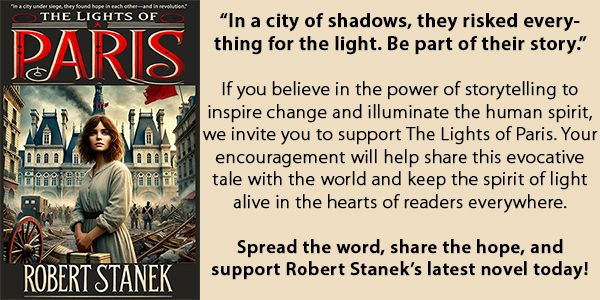
Support The Lights of Paris by Robert Stanek, William Stanek's pen name! Through vivid historical detail and deeply moving character stories, Robert takes readers on an unforgettable journey through one of history’s most transformative times.

